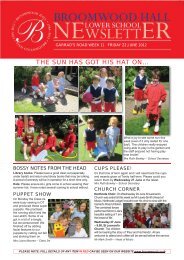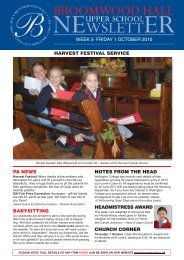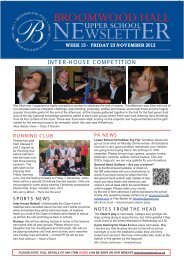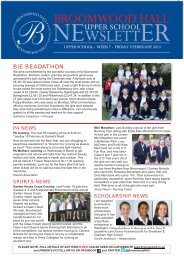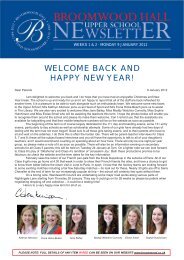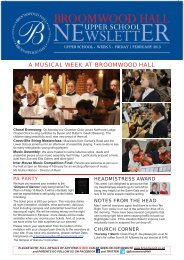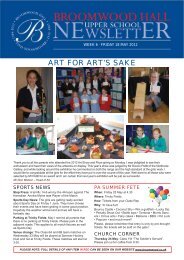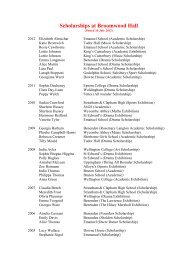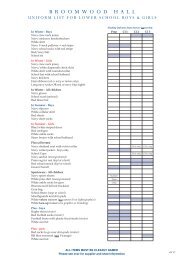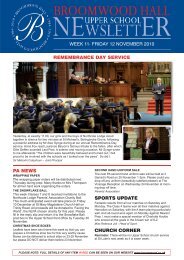of policies - Broomwood Hall
of policies - Broomwood Hall
of policies - Broomwood Hall
Create successful ePaper yourself
Turn your PDF publications into a flip-book with our unique Google optimized e-Paper software.
EARLY YEARS FOUNDATION STAGE<br />
EDUCATIONAL VISITS - RISK ASSESSMENTS<br />
Introduction<br />
<strong>Broomwood</strong> <strong>Hall</strong> is legally required to have risk assessments in place that cover a great many <strong>of</strong> their<br />
activities, including the many educational visits and trips made by all <strong>of</strong> their pupils. However, the<br />
Government places additional requirements on schools that cater for the youngest age group, which at<br />
<strong>Broomwood</strong> <strong>Hall</strong> is the Prep Classes. This policy is a companion document to our policy “EYFS -<br />
Educational Visits”<br />
What is a risk assessment?<br />
Anyone involved in the planning <strong>of</strong> a school trip must be 100% sure they have done all they can to create<br />
a safe environment for the pupils. A risk assessment is a tool for conducting a formal examination <strong>of</strong> the<br />
harm or hazard to people (or an organisation) that could result from a particular activity or situation.<br />
• A hazard is something with the potential to cause harm<br />
• A risk is an evaluation <strong>of</strong> the probability (or likelihood) <strong>of</strong> the hazard occurring<br />
• A risk assessment is the resulting assessment <strong>of</strong> the severity <strong>of</strong> the outcome (e.g. loss <strong>of</strong> life,<br />
destruction <strong>of</strong> property)<br />
• Risk control measures are the measures and procedures that are put in place in order to<br />
minimise the consequences <strong>of</strong> unfettered risk (e.g. staff training, clear work procedures,<br />
preliminary visits and insurance).<br />
The starting point<br />
The starting point for conducting a risk assessment on an outing is to:<br />
• Identify all <strong>of</strong> the potential hazards, such as a child getting lost, or run over, a traffic accident, a<br />
child falling over, sun burn, getting cold or wet on an outing.<br />
• Consider who might be affected by the hazards? The children, staff, volunteers, school<br />
property, school reputation. Children with any special needs need to be considered separately.<br />
• Identify which safety measures will reduce the potential impact <strong>of</strong> the hazard? Examples<br />
include: using a higher staff ratio on all outings than are used inside the school, ensuring that one<br />
member <strong>of</strong> the party is qualified in Paediatric First Aid, frequent head counts, a clear missing<br />
child policy that is known to all, taking a first aid kit and water, asking parents to send<br />
appropriate protective clothing to mitigate impact <strong>of</strong> weather, sound preparation in advance,<br />
including briefing all <strong>of</strong> the adults (staff and volunteers) on their respective roles. Emergency<br />
procedures should be rehearsed in advance with the accompanying staff.<br />
A sample <strong>of</strong> our internal risk assessment for EYFS outings is attached to this policy. Our own risk<br />
assessment analysis is <strong>of</strong>ten supplemented by a risk assessment from the venue itself which is specifically<br />
tailored to the needs <strong>of</strong> visiting school parties and supplied to us by the management <strong>of</strong> that organisation.



